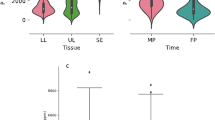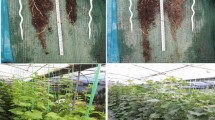Abstract
The genotypic differences in nitrogen (N) utilization efficiency of third backcrossed (BC3) progenies of Sena (Capsicum annuum L.; recurrent parent) and Kopan (Chile penguin; donor parent) pepper plants were determined by examining the changes in the shoot growth at agronomical, root growth at morphological and leaf development at physiological levels under high and low N rates. A hydroponic experiment was conducted by using an aerated deep water culture (DWC) technique in a controlled growth chamber in the spring 2015 growing season. As plant materials, five pepper plants (BC3‑1, BC3‑2, BC3‑3, BC3‑4, BC3-5) were selected from the third backcrossed (BC3) progenies of Sena and Kopan. Plants were grown in 8 L pots filled continuously aerated nutrient solution under at low N (0.5 mM N) and high N (3.0 mM N) rates in randomized complete block design (RCBD) with four replications for 6 weeks. At the experiment plant growth, leaf, shoot and root fresh and dry weights, total leaf area, leaf chlorophyll content (SPAD), total root length, total root volume and average root diameter in pepper plants were assessed. Significant differences in N efficiency were observed between the backcrossed pepper progenies and their respective parents. Leaf, and shoot fresh and dry weights, total leaf area, and leaf chlorophyll content (SPAD) of pepper plants were significantly increased with increasing N rate: 3.0 mM N increased leaf fresh weight by 149.8%, shoot fresh weight by 116.4%, shoot dry weight by 119.6%, total leaf area by 94.54%, and SPAD by 21.28% at BC3‑3 plants as compared to progenies of third backcrosses and their respective parents. Regarding root morphological parameters, pepper plants under high N rate displayed a lower performance than plants under low N rate. Increasing N rate led to a decrease in root fresh weight by 37.96%, and root dry weight by 35.93%. Overall, the N efficiency of the progeny of BC3‑3 was highly associated with vigorous root growth (root fresh and dry weight, total root length and volume) and photosynthetically active leaves (total leaf area, and leaf chlorophyll index) under low N conditions, which could be useful to select and breed “N efficient” pepper varieties.
Zusammenfassung
Ziel dieser Studie war es, die genotypischen Unterschiede in der N‑Effizienz der dritten rückgekreuzten (BC3) Nachkommenschaft der Paprikapflanzen Sena (Capsicum annuum L.; wiederkehrender Elternteil) und Kopan (Chile penguin; Spender-Elternteil) zu bestimmen, indem die Veränderungen im Sprosswachstum auf agronomischer, im Wurzelwachstum auf morphologischer und in der Blattentwicklung auf physiologischer Ebene unter hohen und niedrigen N‑Raten untersucht wurden. Ein hydroponischer Versuch wurde unter Verwendung einer belüfteten Deep-water-culture(DWC)-Technik in einer kontrollierten Wachstumskammer der Erciyes-Universität, Landwirtschaftliche Fakultät in Kayseri, Türkei, angelegt. Der Versuch wurde in der Frühjahrssaison 2015 durchgeführt. Als Pflanzenmaterial wurden fünf Paprikapflanzen (BC3‑1, BC3‑2, BC3‑3, BC3‑4, BC3-5) aus der dritten rückgekreuzten (BC3) Nachkommenschaft von Sena und Kopan ausgewählt. Die Pflanzen wurden in 8‑Liter-Töpfen, die mit kontinuierlich belüfteter Nährlösung gefüllt waren, in zwei verschiedenen N‑Raten (Low-N : 0,5 mM N und High-N : 3,0 mM N) in einem randomisierten Blockdesign (RCBD) mit vier Wiederholungen sechs Wochen lang angebaut. Während des Versuchs wurden Pflanzenwachstum, Blatt‑, Spross- und Wurzel-Frisch- und -Trockengewicht, Gesamtblattfläche, Blattchlorophyllgehalt (SPAD), Gesamtwurzellänge, Gesamtwurzelvolumen und durchschnittlicher Wurzeldurchmesser bei Paprikapflanzen ermittelt. Den Ergebnissen zufolge gab es signifikante Unterschiede in der N‑Effizienz zwischen den rückgekreuzten Paprika-Nachkommen und ihren jeweiligen Eltern. Blatt- und Spross-Frisch- und -Trockengewicht, Gesamtblattfläche und Blattchlorophyllgehalt (SPAD) der Paprikapflanzen nahmen mit steigender N‑Rate signifikant zu; 3,0 mM N erhöhte das Blattfrischgewicht um 149,8 %, das Triebfrischgewicht um fast 116,4 %, das Triebtrockengewicht um fast 119,6 %, die Gesamtblattfläche um 94,54 % und den SPAD-Gehalt um fast 21,28 % bei BC3-3-Pflanzen im Vergleich zu den Nachkommen der dritten Rückkreuzung und ihren jeweiligen Eltern. Andererseits zeigten Paprikapflanzen mit hoher N‑Rate eine geringere Leistung bei den morphologischen Parametern der Wurzeln als Pflanzen mit niedriger N‑Rate. Eine Erhöhung der N‑Rate führte umgekehrt zu einem Rückgang des Frischgewichts der Wurzeln um fast 37,96 % und des Trockengewichts der Wurzeln um fast 35,93 %. Aus der Gesamtleistung konnte geschlossen werden, dass insbesondere die N‑Effizienz der Nachkommenschaft von BC3‑3 in hohem Maße mit einem kräftigen Wurzelwachstum (Wurzel-Frisch- und -Trockengewicht, Gesamtwurzellänge und -volumen) und photosynthetisch aktiven Blättern (Gesamtblattfläche und Blattchlorophyll-Index) unter niedrigen N‑Bedingungen verbunden war. Diese Eigenschaften könnten nützliche Merkmale für die Auswahl und Züchtung von „N-effizienten“ Paprikasorten für eine nachhaltige Landwirtschaft in der Zukunft sein.


Similar content being viewed by others
References
Abrol YP, Chatterjee SR, Kumar PA, Jain V (1999) Improvement in nitrogen use efficiency: physiological and molecular approaches. Curr Sci 76:1357–1364
Adam MB (2018) Genotypic differences in nitrogen efficiency and rootstock potential of some local Tomato varieties of Ghana and Turkey. Erciyes University, Graduate School of Natural and Applied Sciences, Kayseri (Master Thesis)
Balliu A, Sallaku G, Kuci S (2008) Nitrogen concentration in nutrient solution and module volume effects on the growth characters and yield potentials of eggplant seedlings. J Acta Hortic 801:1373–1377
Bloom AJ (2015) The increasing importance of distinguishing among plant nitrogen sources. Curr Opin Plant Biol 25:10–16
Burns IG (1996) Nitrogen supply, growth and development. Acta Hortic 428:21–30
Cardarelli M, Rouphael Y, Muntean D, Colla G (2015) Growth, quality index, and mineral composition of five ornamental cabbage cultivars grown under different nitrogen fertilization rates. HortScience 50(5):688–693
Fageria NK, Baligar VC, Li YC (2008) The role of nutrient efficient plants in improving crop yields in the twenty first century. J of Plant Nutrition. https://doi.org/10.1080/01904160802116068
Filella I, Serrano L, Serra J, Penuelas J (1995) Evaluating wheat nitrogen status with canopy reflectance indices and discriminant analysis. Crop Sci 35:1400–1405
Good AG, Shrawat AK, Muench DG (2004) Can less yield more? Is reducing nutrient input into the environment compatible with maintaining crop production? Trends Plant Sci 9:597–605
Gupta CR, Sangar SS (2000) Response of tomato (Lycopersicon esculentum Mill.) to nitrogen and potassium fertilization in acidic soil of Bastar. Veg Sci 27(1):94–95
Harris P (1992) Mineral nutrition. In: Harris P (ed) The potato crop. Chapman and Hall, London, pp 162–213
Hawkesford MJ, Griths S (2019) Exploiting genetic variation in nitrogen use effciency for cereal crop improvement. Curr Opin Plant Biol 49:35–42
Hawkesford M, Horst W, Kichey T, Lambers H, Schjoerring JK, Moller IS, White P (2012) Functions of macronutrients. In: Marschner P (ed) Marschner’s mineral nutrition of higher plants, 3rd edn. Academic Press, San Diego, pp 135–189
Hirel B, Le Gouis J, Ney B, Gallais A (2007) The challenge of improving nitrogen use efficiency in crop plants: towards a more central role for genetic variability and quantitative genetics within integrated approaches. J Exp Bot 58(9):2369–2387
Holmes FM (1937) Inheritance of resistance to tobacco mosaic disease in pepper. Phytopathology 27:637–642
Hyatt C, Venterea R, Rosen C, McNearney M, Wilson M, Dolan M (2010) Polymer-coated urea maintains potato yields and reduces nitrous oxide emissions in a Minnesota loamy sand. Soil Sci Soc Am J 74(2010):419–428
Isla R, Guillén M, Salmerón M (2016) Nitrogen availability effects on gas exchange measurements in field-grown maize (Zea mays L.) under irrigated Mediterranean conditions. Span J Agric Res 14(4):e806
Khambanonda I (1950) Quantitative inheritance of fruit size in red pepper (Capsicum frutescens L.). Nat Genet 35:322–343
Labconco C (1998) A guide to Kjeldahl nitrogen determination methods and apparatus. Labconco Corporation, Houston
Lemaire G (2001) Ecophysiology of grassland: Dynamic aspects of forage plant population in grazed swards. In: Proceedings of the XIX International Grassland Congress, pp 29–37
Machado AT, Fernandes MS (2001) Participatory maize breeding for low nitrogen tolerance. Euphytica 122:567–573
Magdatena VC (2003) Salinity and nitrogen rate effects of the growth and yield of chille pepper plants. J Soil Sci 67:1781–1789
Malik YS, Bhatia AK, Singh N, Nehra BK, Khurana SC (2002) Effect of nitrogen, seed size and spacing on potato production in cv. Kufri Sutlej. In: Potato, global research and development, vol 2, pp 861–865
Merrill SD, Tanaka DL, Hanson JD (2002) Root length growth of eight crop species in haplustoll soils. Soil Sci Soc Am J 66:913–923
Montemurro F, Diacono M (2016) Towards a better understanding of agronomic efficiency of nitrogen: assessment and improvement strategies. Agronomy 6:31. https://doi.org/10.3390/agronomy6020031
Mosier AR, Syers JK, Freney JR (2004) Agriculture and the nitrogen cycle. Assessing the impacts of fertilizer use on food production and the environment. Scope-65. Island Press, London
Ouda BA, Mahadeen AY (2008) Effect of fertilizers on growth, yield, yield components, quality and certain nutrient contents in broccoli (Brassica oleracea). Int J Agri Biol 10:627–632
Pervez MA, Ayub CM, Bashart A, Nave AV, Nasir M (2004) Effect of nitrogen levels and spacing on growth and yield of radish (Raphanus sativus L.). Int J Agric Biol 6(3):504–506
Ruiz JM, Rivero RM, Cervilla LM, Castellano R, Romero L (2006) Grafting to improve nitrogen-use efficiency traits in tobacco plants. J Sci Food Agric 86(6):1014–1021
Sattelmacher B, Horst WJ, Becker HC (1994) Factors that contribute to genetic variation for nutrient efficiency of crop plants. Z Pflanzenernährung Bodenkd 157:215–224
Schulte Auf’m Erley G, Wijaya KA, Ulas A, Becker H, Wiesler F, Horst WJ (2007) Leaf senescence and N uptake parameters as selection traits for nitrogen efficiency of oilseed rape cultivars. Physiol Plant 130:519–531
Subramanya R (1983) Transfer of genes for increased flower number in pepper. HortScience 18:747–749
Takebe M, Ishihara T, Matsuna K, Fojimoto J, Yoneyama T (1995) Effect of nitrogen application on the content of sugars, ascorbic acid, nitrate and oxalic acid in spinach (Spinacia oleracea L.) and komatsuna (Nrasica compestris L.). Jpn J Soil Sci Plant Nutr 66:238–246
Tripodi P, Kumar S (2019) (2019). The Capsicum Crop: An Introduction. In: Ramchiary N, Kole C (eds) The Capsicum genome. Springer, Cham, pp 1–8 https://doi.org/10.1007/978-3-319-97217-6_1
Ulas A, Doganci E, Ulas F, Yetisir H (2019) Root-growth characteristics contributing to genotypic variation in nitrogen efficiency of bottle gourd and rootstock potential for watermelon. Plants 8:77
Ulas A, Schulte auf’m Erley G, Kamh M, Wiesler F, Horst WJ (2012) Root-growth characteristics contributing to genotypic variation in nitrogen efficiency of oilseed rape. J Plant Nutr Soil Sci 175:489–498
Ulas A, Behrens T, Wiesler F, Horst WJ, Schulte auf’m Erley G (2013) Does genotypic variation in nitrogen remobilisation efficiency contribute to nitrogen efficiency of winter oilseed-rape cultivars (Brassica napus L.)? Plant Soil 371:463–471
Ulas F, Erdogdu S, Yetisir H, Ulas A (2021b) Investigation on morphology and physiology of nitrogen efficiency in different pepper (Capsicum annuum L.) inbred lines. Genetika 53(3):1325–1344
Ulas F, Yetisir H, Ulas A (2021a) Root-growth characteristics contributing to nitrogen efficiency of reciprocally grafted potatoes (Solanum tuberosum L.) under hyroponic conditions. Gesunde Pflanz. https://doi.org/10.1007/s10343-021-00560-8
Westermann DT (2005) Nutritional requirements of potatoes. Am J Potato Res 82(4):301–307
Yohannes U (1994) The effect of nitrogen, phosphorus, potassium and sulphur on the yield and yield components of Ensete (Ensete ventricosum W.) in Southwest of Ethiopia. Ph.D. Thesis, Giessen
Yoon JB, Yang DC, Do JW, Park HG (2006) Overcoming two Post-Fertilization genetic barriers in interspecific hybridization between Capsicum annuum into Capsicum baccatum for introgression of anthracnose resistance. Breed Sci 56:31–38
Yücel YC (2020) Agronomical, physiological and morphological characterization of some selected eggplant (Solanum melongena L.) genotypes for nitrogen efficiency and rootstock potential. Master Thesis. Erciyes University, Graduate School of Natural and Applied Sciences, Kayseri (in Turkish)
Zebarth BJ, Rosen CJ (2007) Research perspective on nitrogen BMP development for potato. Am J Potato Res 84:3–18
Zhang Y, Wang H, Lei Q, Luo J, Lindsey S, Zhang J, Zhai L, Wu S, Zhang J, Liu X et al (2018) Optimizing the nitrogen application rate for maize and wheat based on yield and environment on the Northern China Plain. Sci Total Environ 618:1173–1183
Funding
This research received no external funding.
Author information
Authors and Affiliations
Corresponding author
Ethics declarations
Conflict of interest
A. Ulas, H. Yetisir and F. Ulas declare that they have no competing interests.
Rights and permissions
About this article
Cite this article
Ulas, A., Yetisir, H. & Ulas, F. Genotypic Variation in Nitrogen Utilization Efficiency of Pepper (Capsicum Annuum L.) Under Different Nitrogen Supply in Hydroponic Conditions. Gesunde Pflanzen 74, 629–638 (2022). https://doi.org/10.1007/s10343-022-00637-y
Received:
Accepted:
Published:
Issue Date:
DOI: https://doi.org/10.1007/s10343-022-00637-y




